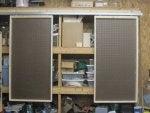Hi all, new member checking in with a question on making freestanding garage/storage shelves with framing done using 2x4's. I've got a 20-ish ft run in a warehouse setup that I'm hoping to build about 10' tall. 22" or so depth. Vertical riser every 6' or so. 1/2 ply for the shelves themselves.
As far as tools go I've got a 3/4hp DeWalt RAS, a skilsaw, and a Ryobi router with plunge base, an old large craftsman bandsaw, and an old craftsman drill press. The last time I built shelves I cut a notch in the vertical posts wide enough to lay the cross members into but it was kind of a pita since I cut the notches with the skillsaw. Went together well enough, but if I was to do it again I'd stick a dado in the RAS and cut them that way.
I'm wondering if using loose tenons, and cutting the mortise with the router would be provide enough stability on the tall shelving unit, while being quick to assemble? I looked around for a jig that would let me cut the tenons and round them at the same time but no luck. Guess I could fart around and build a jig but hoping to make this a fast project vs endless tinkering. I was thinking about doweling as well but that seems like a lot of drilling. Any suggestions ?
As far as tools go I've got a 3/4hp DeWalt RAS, a skilsaw, and a Ryobi router with plunge base, an old large craftsman bandsaw, and an old craftsman drill press. The last time I built shelves I cut a notch in the vertical posts wide enough to lay the cross members into but it was kind of a pita since I cut the notches with the skillsaw. Went together well enough, but if I was to do it again I'd stick a dado in the RAS and cut them that way.
I'm wondering if using loose tenons, and cutting the mortise with the router would be provide enough stability on the tall shelving unit, while being quick to assemble? I looked around for a jig that would let me cut the tenons and round them at the same time but no luck. Guess I could fart around and build a jig but hoping to make this a fast project vs endless tinkering. I was thinking about doweling as well but that seems like a lot of drilling. Any suggestions ?





